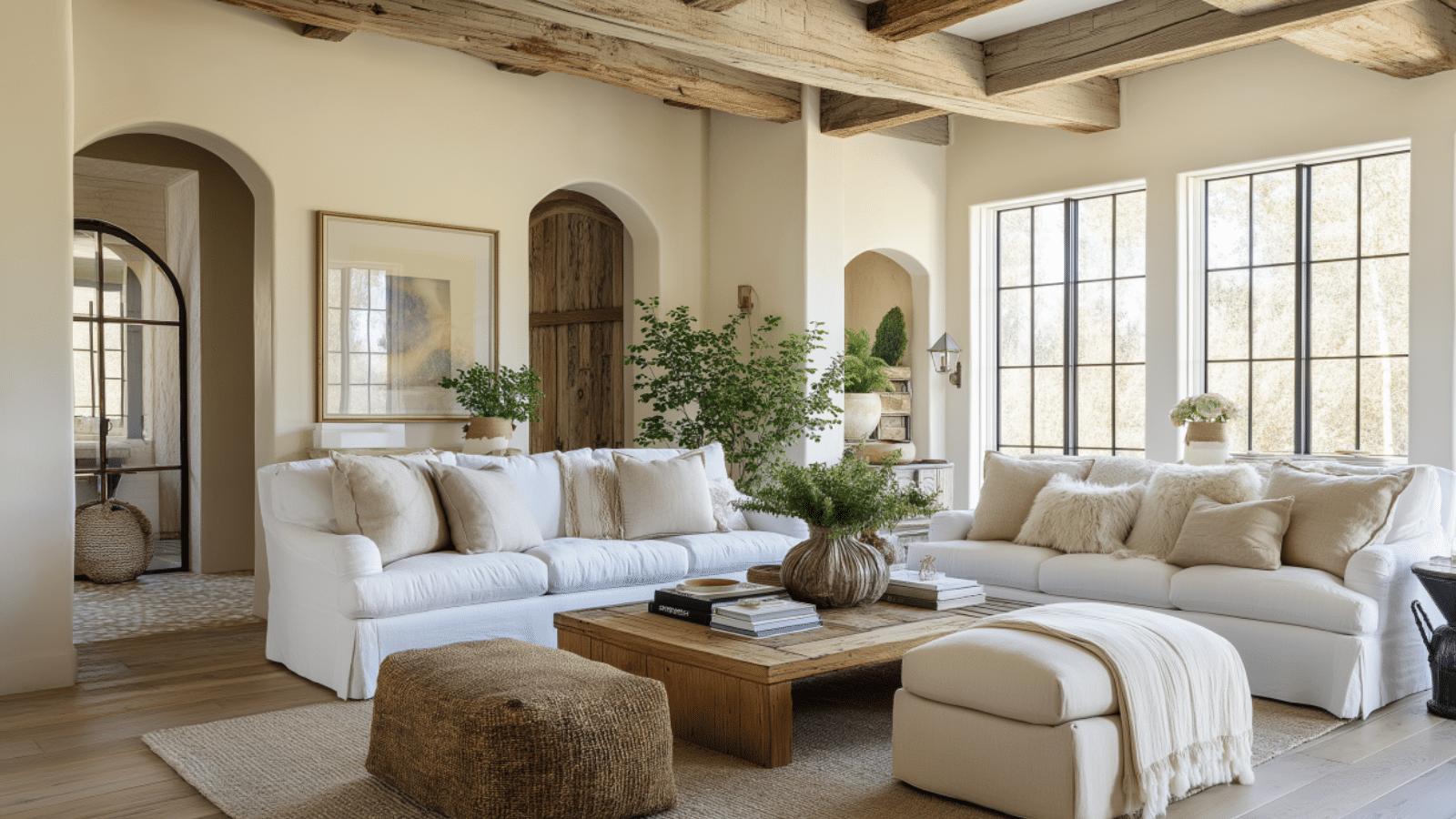Country Farmhouse Living Room With Soft Whites and Wood Tones: A Cozy and Timeless Design Guide
Table of Contents
There’s something undeniably soothing about a country farmhouse living room. The blend of soft whites and rich wood tones creates an inviting space that’s both timeless and stylish. According to interior design surveys, over 65% of homeowners are drawn to the farmhouse aesthetic for its warmth, simplicity, and lived-in charm. But what truly makes a country farmhouse living room feel elevated yet cozy? It’s all in the thoughtful mix of materials, hues, and textures.
Whether you’re decorating a countryside retreat or bringing a farmhouse flair into a modern setting, this look can be tailored to fit your lifestyle. The combination of neutral palettes with organic textures like wood, linen, and stone creates a restful environment while still allowing space for personality. From vintage accessories to updated furniture with classic lines, the possibilities are endless.
This blog post will walk you through how to design a country farmhouse living room using soft whites and wood tones. You’ll discover everything from foundational color theory to furniture selection, layered textiles, and finishing touches that bring the space to life. With practical advice and visual breakdowns, you’ll be inspired to create a room that radiates comfort, character, and understated beauty.
Create a Warm Foundation With the Right Color Palette
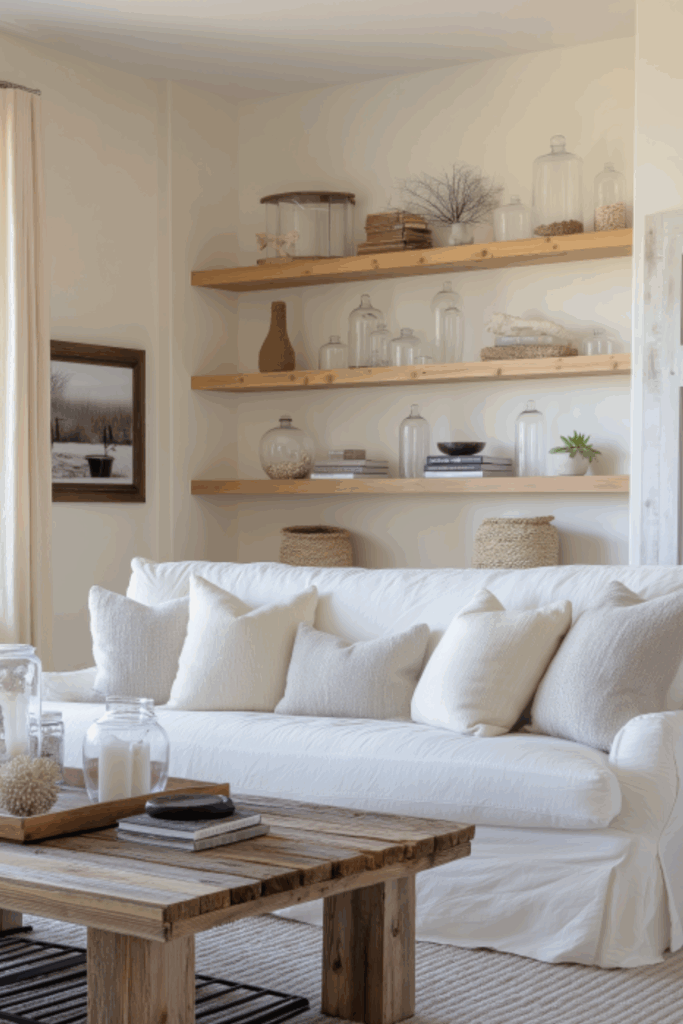
At the heart of any country farmhouse design is its color story. Soft whites serve as the canvas—inviting light into the space and making even the smallest room feel expansive. But not all whites are created equal. Cream, ivory, antique white, and warm greige shades bring softness and avoid the clinical feel of pure white.
Complement these tones with warm wood finishes. Think honey oak, aged pine, or walnut. These hues ground the space and prevent it from feeling too stark. Together, soft whites and wood tones evoke balance—fresh yet grounded, elegant yet rustic.
Table: Country Farmhouse Color Palette Guide
| Element | Color Range | Mood Created |
|---|---|---|
| Walls | Cream, warm white, ivory | Soft, clean backdrop |
| Flooring | Natural oak, reclaimed pine | Earthy, grounding warmth |
| Furniture | Light wood, soft white finishes | Balanced and versatile |
| Accents | Woven beige, sage green, light gray | Gentle contrast |
Select the Right Furniture for Form and Function
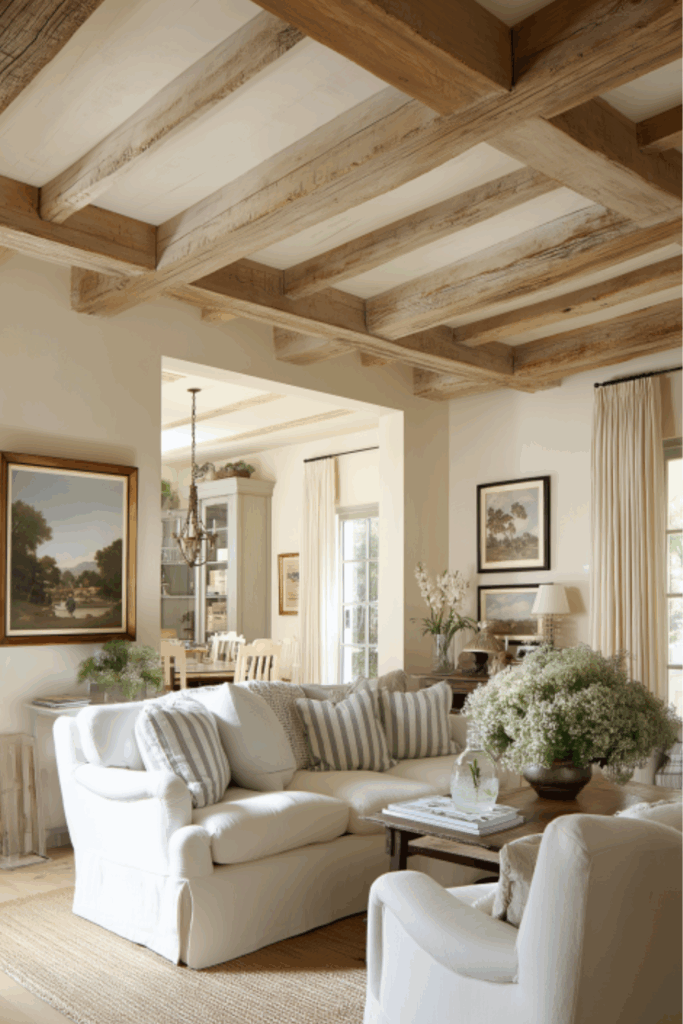
Farmhouse living room furniture should feel both functional and lived-in. Start with a plush sofa in a neutral slipcover—white or oatmeal linen is ideal. These covers are not only practical for busy homes but also reinforce the softness of the palette.
Mix in wooden furniture that features visible grain and distressed finishes. A weathered coffee table, a pine media console, or a reclaimed wood sideboard anchors the room with texture and warmth.
Balance bulkier wood pieces with upholstered seating: accent chairs in ticking stripe, light plaid, or solid neutrals. Keep silhouettes classic but simple—rolled arms, wooden legs, and tufted cushions add subtle detail without overpowering the space.
Table: Key Farmhouse Furniture Elements
| Furniture Piece | Ideal Finish/Material | Styling Benefit |
|---|---|---|
| Sofa | White/oatmeal slipcovered linen | Clean, cozy, easy to maintain |
| Coffee table | Reclaimed wood | Adds rustic charm and texture |
| Side chairs | Neutral fabric with wood frame | Softens space and adds elegance |
| Console/Shelving | Open wood design | Functional display with character |
Layer Textiles for Depth and Comfort
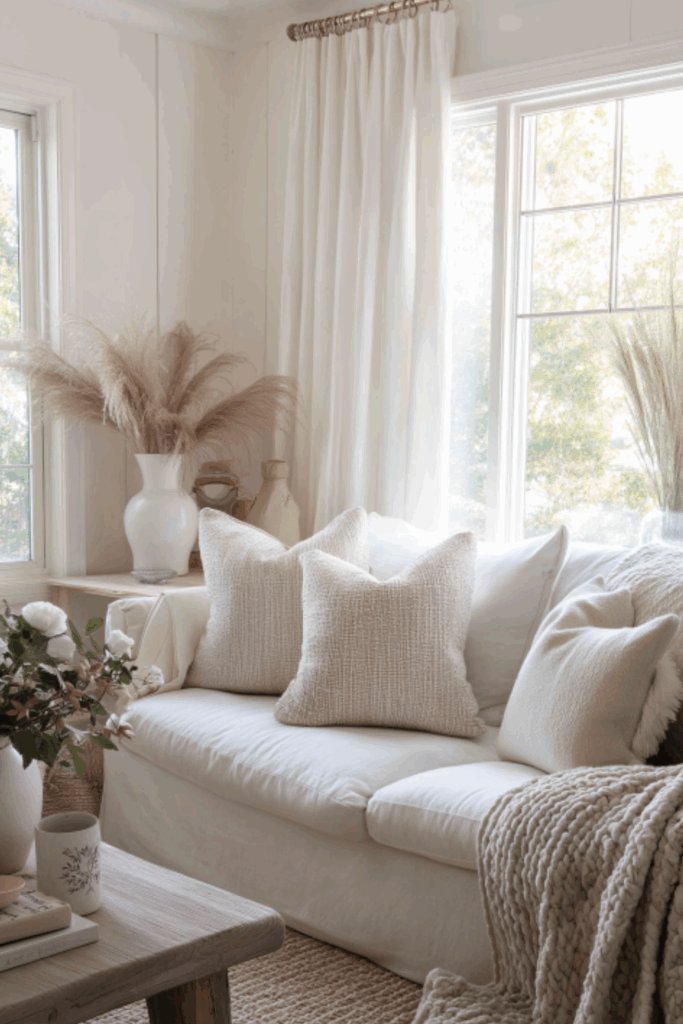
One of the most inviting parts of a farmhouse living room is its tactile comfort. Textiles play a key role in softening a space dominated by wood and white. Think natural fibers like linen, cotton, wool, and jute.
Start by anchoring your room with a large, flat-weave rug in a neutral tone—beige, gray, or muted patterns work well. Layer in throw pillows in mixed textures: nubby linen, embroidered cotton, or subtly striped fabrics. Add a soft throw blanket over the back of a chair or sofa for both warmth and visual interest.
Curtains should be light and breezy. Opt for linen or gauze in cream or natural white, hung from black or brass rods for a gentle contrast. Keep styling casual—think relaxed, unstructured drape versus heavily pleated panels.
Table: Farmhouse Textile Layering Plan
| Textile Type | Recommended Material | Placement/Style Tip |
|---|---|---|
| Rug | Jute, wool-blend, cotton | Use large scale to define space |
| Throw pillows | Linen, canvas, cotton | Vary size and texture for visual depth |
| Throws | Knit, wool, woven blends | Drape casually for warmth and softness |
| Curtains | Gauze, light linen | Let fabric puddle slightly on the floor |
Incorporate Natural and Vintage Elements
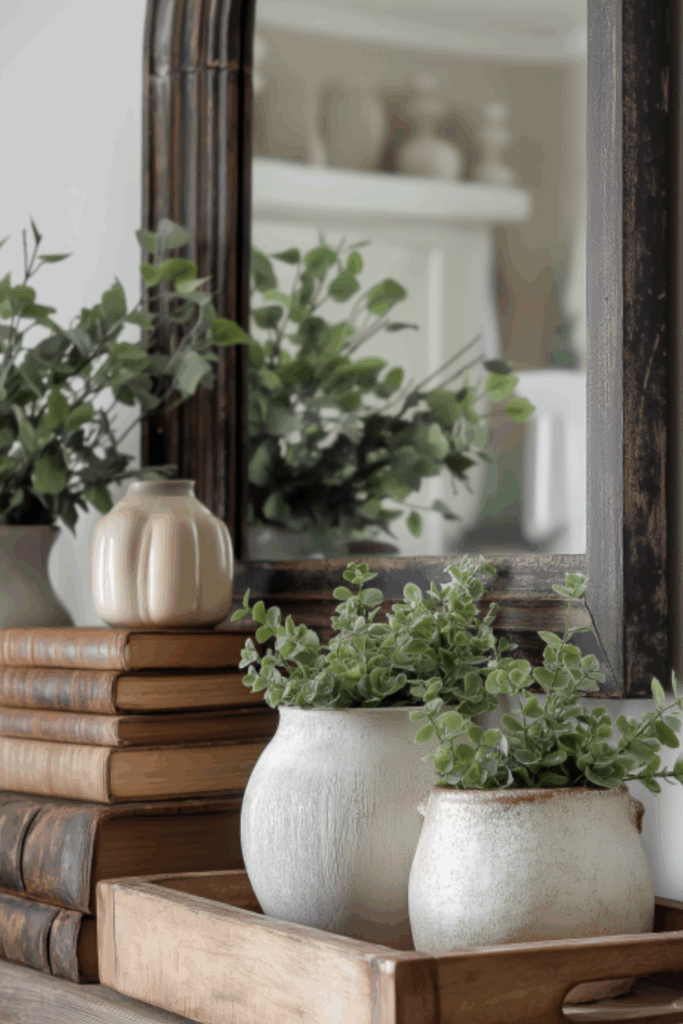
Bringing nature inside is essential to country living room style. Decorate with dried eucalyptus, olive branches, or simple potted greenery in terracotta or ceramic pots. These earthy touches add color and life to an otherwise neutral space.
Vintage or vintage-inspired pieces infuse character. Think old crates turned into storage, antique mirrors with patina, or rustic wooden trays. Scour flea markets for worn books, lanterns, or metal baskets to display on shelves or coffee tables.
Balance is key. You don’t want the space to feel cluttered, so curate your décor sparingly. Group items in odd numbers and vary the height for layered visual interest.
Table: Natural & Vintage Styling Ideas
| Item Type | Suggested Look/Finish | Placement Idea |
|---|---|---|
| Greenery | Dried or fresh in neutral vase | Console or coffee table centerpiece |
| Vintage décor | Distressed wood, metal, leather | Bookshelf or sideboard accent |
| Found objects | Wooden bowls, antique clocks | Mantel styling or table décor |
| Wall accents | Aged mirror, framed botanical prints | Create visual height and interest |
Add Personality Through Subtle Decorative Accents
Minimal doesn’t have to mean boring. In a neutral farmhouse living room, your accessories are where personality shines. Use black metal accents—like curtain rods or picture frames—for a subtle contrast against all the soft white. Include framed family photos, artwork in sepia tones, or muted landscapes.
Incorporate handmade items like pottery, woven baskets, or candle holders. Place a rustic tray on the coffee table filled with candles, a stack of linen coasters, and a bud vase. Wall décor can be understated: consider a set of vintage clocks, a reclaimed wood sign, or layered cutting boards for a touch of warmth.
Table: Accessory Styling Breakdown
| Accent Piece | Material Style | Where to Use |
|---|---|---|
| Baskets | Woven, rattan, jute | Organize blankets or magazines |
| Artwork | Neutrals, nature scenes | Gallery wall or above sofa |
| Tabletop accents | Wood tray, candles | Coffee table or entry bench |
| Throw pillow details | Buttons, fringe, hand-stitch | Add texture without bold color |
Lighting That Complements and Warms the Space
Lighting in a country farmhouse living room is soft, ambient, and often layered. Start with natural light—opt for large windows, glass doors, or light-filtering curtains to let daylight in.
Overhead lighting should be functional yet elegant. A wrought iron chandelier or a wooden-beam-inspired pendant adds charm and draws the eye upward. Table lamps in ceramic or weathered wood bases with linen shades introduce cozy lighting zones.
Consider accent lighting, too. Wall sconces near reading areas or candle sconces flanking a mirror help create warm, inviting pockets. Lantern-style floor lamps or vintage task lights round out the space.
Dimmers are highly recommended to control ambiance depending on the time of day.
Table: Farmhouse Lighting Essentials
| Lighting Type | Material/Style | Best Placement |
|---|---|---|
| Overhead chandelier | Iron, wood, matte finishes | Center of room or above seating area |
| Table lamps | Ceramic, glass, linen shade | End tables or sideboard corners |
| Wall sconces | Metal with exposed bulb | Beside artwork or fireplace |
| Floor lamp | Lantern or task-style | Reading nook or corner styling |
Conclusion
A country farmhouse living room styled with soft whites and wood tones offers the perfect balance of warmth, simplicity, and timeless beauty. Whether you’re starting from scratch or making small updates, embracing this design philosophy can transform your space into a peaceful retreat. By focusing on a soft color palette, mixing natural textures, choosing the right furniture, and layering in personal accents, your living room will radiate comfort and charm.
The real beauty of farmhouse style lies in its lived-in, welcoming feel—a space that invites you to slow down and enjoy the moment. With these thoughtful elements in place, your home will not only look beautiful but feel deeply comforting, no matter the season.

